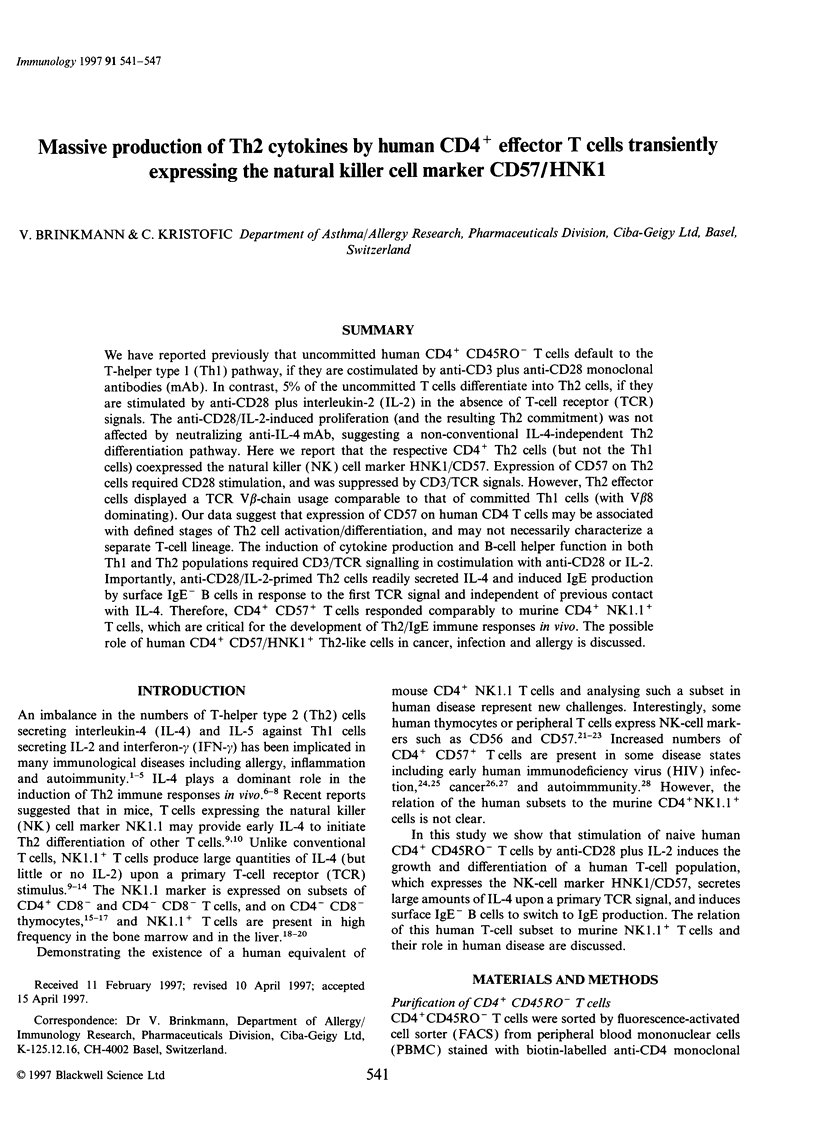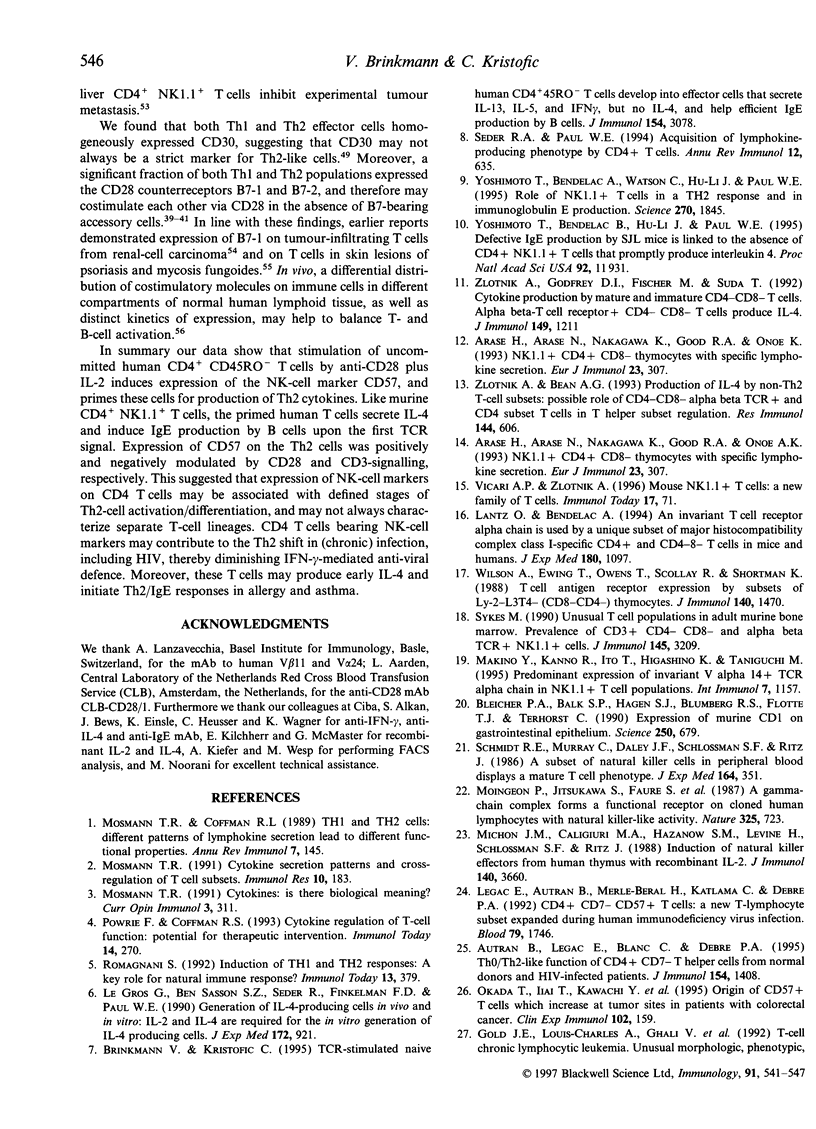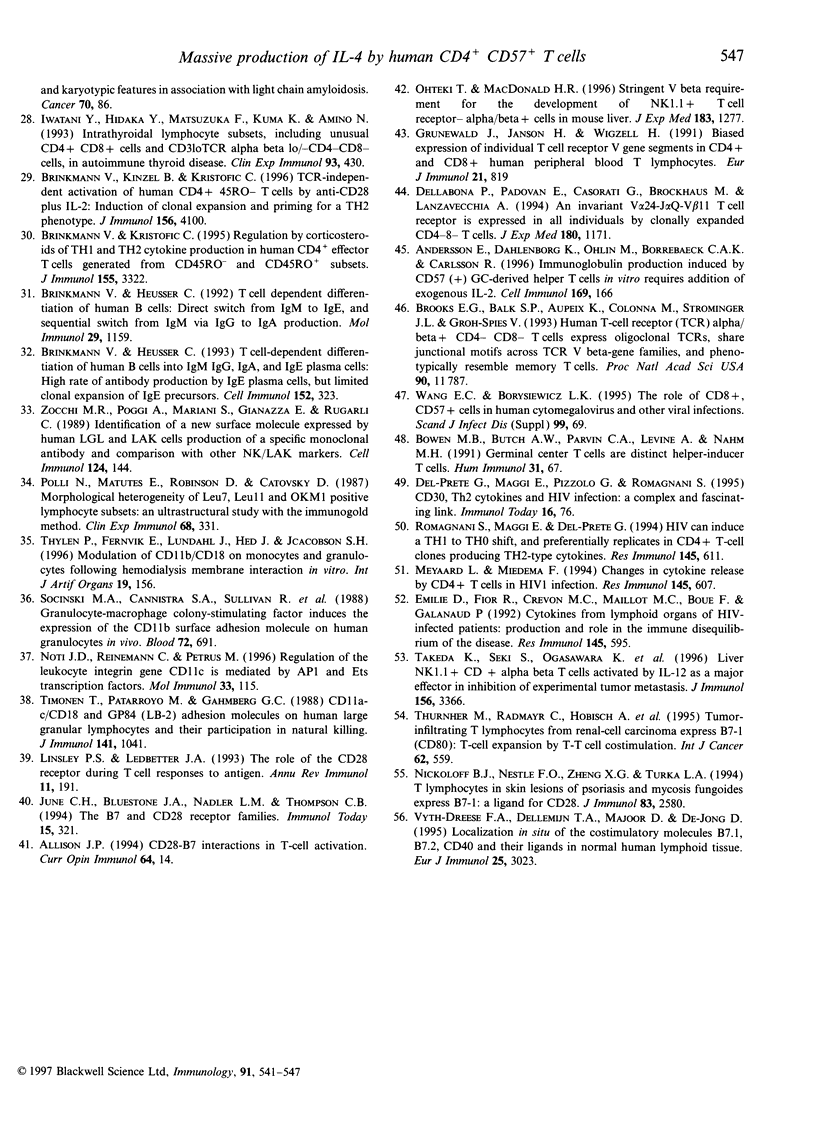Abstract
We have reported previously that uncommitted human CD4+ CD45RO- T cells default to the T-helper type 1 (Th1) pathway, if they are costimulated by anti-CD3 plus anti-CD28 monoclonal antibodies (mAb). In contrast, 5% of the uncommitted T cells differentiate into Th2 cells, if they are stimulated by anti-CD28 plus interleukin-2 (IL-2) in the absence of T-cell receptor (TCR) signals. The anti-CD28/IL-2-induced proliferation (and the resulting Th2 commitment) was not affected by neutralizing anti-IL-4 mAb, suggesting a non-conventional IL-4-independent Th2 differentiation pathway. Here we report that the respective CD4+ Th2 cells (but not the Th1 cells) coexpressed the natural killer (NK) cell marker HNK1/CD57. Expression of CD57 on Th2 cells required CD28 stimulation, and was suppressed by CD3/TCR signals. However, Th2 effector cells displayed a TCR V beta-chain usage comparable to that of committed Th1 cells (with V beta 8 dominating). Our data suggest that expression of CD57 on human CD4 T cells may be associated with defined stages of Th2 cell activation/differentiation, and may not necessarily characterize a separate T-cell lineage. The induction of cytokine production and B-cell helper function in both Th1 and Th2 populations required CD3/TCR signalling in costimulation with anti-CD28 or IL-2. Importantly, anti-CD28/IL-2-primed Th2 cells readily secreted IL-4 and induced IgE production by surface IgE- B cells in response to the first TCR signal and independent of previous contact with IL-4. Therefore, CD4+ CD57+ T cells responded comparably to murine CD4+ NK1.1+ T cells, which are critical for the development of Th2/IgE immune responses in vivo. The possible role of human CD4+ CD57/HNK1+ Th2-like cells in cancer, infection and allergy is discussed.
Full text
PDF






Selected References
These references are in PubMed. This may not be the complete list of references from this article.
- Andersson E., Dahlenborg K., Ohlin M., Borrebaeck C. A., Carlsson R. Immunoglobulin production induced by CD57+ GC-derived helper T cells in vitro requires addition of exogenous IL-2. Cell Immunol. 1996 May 1;169(2):166–173. doi: 10.1006/cimm.1996.0107. [DOI] [PubMed] [Google Scholar]
- Arase H., Arase N., Nakagawa K., Good R. A., Onoé K. NK1.1+ CD4+ CD8- thymocytes with specific lymphokine secretion. Eur J Immunol. 1993 Jan;23(1):307–310. doi: 10.1002/eji.1830230151. [DOI] [PubMed] [Google Scholar]
- Arase H., Arase N., Nakagawa K., Good R. A., Onoé K. NK1.1+ CD4+ CD8- thymocytes with specific lymphokine secretion. Eur J Immunol. 1993 Jan;23(1):307–310. doi: 10.1002/eji.1830230151. [DOI] [PubMed] [Google Scholar]
- Autran B., Legac E., Blanc C., Debré P. A Th0/Th2-like function of CD4+CD7- T helper cells from normal donors and HIV-infected patients. J Immunol. 1995 Feb 1;154(3):1408–1417. [PubMed] [Google Scholar]
- Bleicher P. A., Balk S. P., Hagen S. J., Blumberg R. S., Flotte T. J., Terhorst C. Expression of murine CD1 on gastrointestinal epithelium. Science. 1990 Nov 2;250(4981):679–682. doi: 10.1126/science.1700477. [DOI] [PubMed] [Google Scholar]
- Bowen M. B., Butch A. W., Parvin C. A., Levine A., Nahm M. H. Germinal center T cells are distinct helper-inducer T cells. Hum Immunol. 1991 May;31(1):67–75. doi: 10.1016/0198-8859(91)90050-j. [DOI] [PubMed] [Google Scholar]
- Brinkmann V., Heusser C. H. T cell-dependent differentiation of human B cells into IgM, IgG, IgA, or IgE plasma cells: high rate of antibody production by IgE plasma cells, but limited clonal expansion of IgE precursors. Cell Immunol. 1993 Dec;152(2):323–332. doi: 10.1006/cimm.1993.1294. [DOI] [PubMed] [Google Scholar]
- Brinkmann V., Kinzel B., Kristofic C. TCR-independent activation of human CD4+ 45RO- T cells by anti-CD28 plus IL-2: Induction of clonal expansion and priming for a Th2 phenotype. J Immunol. 1996 Jun 1;156(11):4100–4106. [PubMed] [Google Scholar]
- Brinkmann V., Kristofic C. Regulation by corticosteroids of Th1 and Th2 cytokine production in human CD4+ effector T cells generated from CD45RO- and CD45RO+ subsets. J Immunol. 1995 Oct 1;155(7):3322–3328. [PubMed] [Google Scholar]
- Brinkmann V., Kristofic C. TCR-stimulated naive human CD4+ 45RO- T cells develop into effector cells that secrete IL-13, IL-5, and IFN-gamma, but no IL-4, and help efficient IgE production by B cells. J Immunol. 1995 Apr 1;154(7):3078–3087. [PubMed] [Google Scholar]
- Brinkmann V., Müller S., Heusser C. H. T cell dependent differentiation of human B cells: direct switch from IgM to IgE, and sequential switch from IgM via IgG to IgA production. Mol Immunol. 1992 Oct;29(10):1159–1164. doi: 10.1016/0161-5890(92)90051-x. [DOI] [PubMed] [Google Scholar]
- Del Prete G., Maggi E., Pizzolo G., Romagnani S. CD30, Th2 cytokines and HIV infection: a complex and fascinating link. Immunol Today. 1995 Feb;16(2):76–80. doi: 10.1016/0167-5699(95)80092-1. [DOI] [PubMed] [Google Scholar]
- Dellabona P., Padovan E., Casorati G., Brockhaus M., Lanzavecchia A. An invariant V alpha 24-J alpha Q/V beta 11 T cell receptor is expressed in all individuals by clonally expanded CD4-8- T cells. J Exp Med. 1994 Sep 1;180(3):1171–1176. doi: 10.1084/jem.180.3.1171. [DOI] [PMC free article] [PubMed] [Google Scholar]
- Emilie D., Fior R., Crevon M. C., Maillot M. C., Boue F., Galanaud P. Cytokines from lymphoid organs of HIV-infected patients: production and role in the immune disequilibrium of the disease. Res Immunol. 1994 Oct-Dec;145(8-9):595–602. doi: 10.1016/s0923-2494(05)80039-2. [DOI] [PubMed] [Google Scholar]
- Grunewald J., Janson C. H., Wigzell H. Biased expression of individual T cell receptor V gene segments in CD4+ and CD8+ human peripheral blood T lymphocytes. Eur J Immunol. 1991 Mar;21(3):819–822. doi: 10.1002/eji.1830210342. [DOI] [PubMed] [Google Scholar]
- Iwatani Y., Hidaka Y., Matsuzuka F., Kuma K., Amino N. Intrathyroidal lymphocyte subsets, including unusual CD4+ CD8+ cells and CD3loTCR alpha beta lo/-CD4-CD8- cells, in autoimmune thyroid disease. Clin Exp Immunol. 1993 Sep;93(3):430–436. doi: 10.1111/j.1365-2249.1993.tb08196.x. [DOI] [PMC free article] [PubMed] [Google Scholar]
- June C. H., Bluestone J. A., Nadler L. M., Thompson C. B. The B7 and CD28 receptor families. Immunol Today. 1994 Jul;15(7):321–331. doi: 10.1016/0167-5699(94)90080-9. [DOI] [PubMed] [Google Scholar]
- Lantz O., Bendelac A. An invariant T cell receptor alpha chain is used by a unique subset of major histocompatibility complex class I-specific CD4+ and CD4-8- T cells in mice and humans. J Exp Med. 1994 Sep 1;180(3):1097–1106. doi: 10.1084/jem.180.3.1097. [DOI] [PMC free article] [PubMed] [Google Scholar]
- Le Gros G., Ben-Sasson S. Z., Seder R., Finkelman F. D., Paul W. E. Generation of interleukin 4 (IL-4)-producing cells in vivo and in vitro: IL-2 and IL-4 are required for in vitro generation of IL-4-producing cells. J Exp Med. 1990 Sep 1;172(3):921–929. doi: 10.1084/jem.172.3.921. [DOI] [PMC free article] [PubMed] [Google Scholar]
- Legac E., Autran B., Merle-Beral H., Katlama C., Debre P. CD4+CD7-CD57+ T cells: a new T-lymphocyte subset expanded during human immunodeficiency virus infection. Blood. 1992 Apr 1;79(7):1746–1753. [PubMed] [Google Scholar]
- Linsley P. S., Ledbetter J. A. The role of the CD28 receptor during T cell responses to antigen. Annu Rev Immunol. 1993;11:191–212. doi: 10.1146/annurev.iy.11.040193.001203. [DOI] [PubMed] [Google Scholar]
- Makino Y., Kanno R., Ito T., Higashino K., Taniguchi M. Predominant expression of invariant V alpha 14+ TCR alpha chain in NK1.1+ T cell populations. Int Immunol. 1995 Jul;7(7):1157–1161. doi: 10.1093/intimm/7.7.1157. [DOI] [PubMed] [Google Scholar]
- Meyaard L., Miedema F. Changes in cytokine release by CD4+ T cells in HIV1 infection. Res Immunol. 1994 Oct-Dec;145(8-9):607–611. doi: 10.1016/s0923-2494(05)80041-0. [DOI] [PubMed] [Google Scholar]
- Michon J. M., Caligiuri M. A., Hazanow S. M., Levine H., Schlossman S. F., Ritz J. Induction of natural killer effectors from human thymus with recombinant IL-2. J Immunol. 1988 May 15;140(10):3660–3667. [PubMed] [Google Scholar]
- Moingeon P., Jitsukawa S., Faure F., Troalen F., Triebel F., Graziani M., Forestier F., Bellet D., Bohuon C., Hercend T. A gamma-chain complex forms a functional receptor on cloned human lymphocytes with natural killer-like activity. Nature. 1987 Feb 19;325(6106):723–726. doi: 10.1038/325723a0. [DOI] [PubMed] [Google Scholar]
- Mosmann T. R., Coffman R. L. TH1 and TH2 cells: different patterns of lymphokine secretion lead to different functional properties. Annu Rev Immunol. 1989;7:145–173. doi: 10.1146/annurev.iy.07.040189.001045. [DOI] [PubMed] [Google Scholar]
- Mosmann T. R. Cytokine secretion patterns and cross-regulation of T cell subsets. Immunol Res. 1991;10(3-4):183–188. doi: 10.1007/BF02919690. [DOI] [PubMed] [Google Scholar]
- Mosmann T. R. Cytokines: is there biological meaning? Curr Opin Immunol. 1991 Jun;3(3):311–314. doi: 10.1016/0952-7915(91)90029-z. [DOI] [PubMed] [Google Scholar]
- Nickoloff B. J., Nestle F. O., Zheng X. G., Turka L. A. T lymphocytes in skin lesions of psoriasis and mycosis fungoides express B7-1: a ligand for CD28. Blood. 1994 May 1;83(9):2580–2586. [PubMed] [Google Scholar]
- Noti J. D., Reinemann C., Petrus M. N. Regulation of the leukocyte integrin gene CD11c is mediated by AP1 and Ets transcription factors. Mol Immunol. 1996 Feb;33(2):115–127. doi: 10.1016/0161-5890(95)00140-9. [DOI] [PubMed] [Google Scholar]
- Ohteki T., MacDonald H. R. Stringent V beta requirement for the development of NK1.1+ T cell receptor-alpha/beta+ cells in mouse liver. J Exp Med. 1996 Mar 1;183(3):1277–1282. doi: 10.1084/jem.183.3.1277. [DOI] [PMC free article] [PubMed] [Google Scholar]
- Okada T., Iiai T., Kawachi Y., Moroda T., Takii Y., Hatakeyama K., Abo T. Origin of CD57+ T cells which increase at tumour sites in patients with colorectal cancer. Clin Exp Immunol. 1995 Oct;102(1):159–166. doi: 10.1111/j.1365-2249.1995.tb06650.x. [DOI] [PMC free article] [PubMed] [Google Scholar]
- Polli N., Matutes E., Robinson D., Catovsky D. Morphological heterogeneity of Leu7, Leu11 and OKM1 positive lymphocyte subsets: an ultrastructural study with the immunogold method. Clin Exp Immunol. 1987 May;68(2):331–339. [PMC free article] [PubMed] [Google Scholar]
- Powrie F., Coffman R. L. Cytokine regulation of T-cell function: potential for therapeutic intervention. Immunol Today. 1993 Jun;14(6):270–274. doi: 10.1016/0167-5699(93)90044-L. [DOI] [PubMed] [Google Scholar]
- Romagnani S. Induction of TH1 and TH2 responses: a key role for the 'natural' immune response? Immunol Today. 1992 Oct;13(10):379–381. doi: 10.1016/0167-5699(92)90083-J. [DOI] [PubMed] [Google Scholar]
- Romagnani S., Maggi E., Del Prete G. HIV can induce a TH1 to TH0 shift, and preferentially replicates in CD4+ T-cell clones producing TH2-type cytokines. Res Immunol. 1994 Oct-Dec;145(8-9):611–618. doi: 10.1016/s0923-2494(05)80042-2. [DOI] [PubMed] [Google Scholar]
- Schmidt R. E., Murray C., Daley J. F., Schlossman S. F., Ritz J. A subset of natural killer cells in peripheral blood displays a mature T cell phenotype. J Exp Med. 1986 Jul 1;164(1):351–356. doi: 10.1084/jem.164.1.351. [DOI] [PMC free article] [PubMed] [Google Scholar]
- Seder R. A., Paul W. E. Acquisition of lymphokine-producing phenotype by CD4+ T cells. Annu Rev Immunol. 1994;12:635–673. doi: 10.1146/annurev.iy.12.040194.003223. [DOI] [PubMed] [Google Scholar]
- Socinski M. A., Cannistra S. A., Sullivan R., Elias A., Antman K., Schnipper L., Griffin J. D. Granulocyte-macrophage colony-stimulating factor induces the expression of the CD11b surface adhesion molecule on human granulocytes in vivo. Blood. 1988 Aug;72(2):691–697. [PubMed] [Google Scholar]
- Sykes M. Unusual T cell populations in adult murine bone marrow. Prevalence of CD3+CD4-CD8- and alpha beta TCR+NK1.1+ cells. J Immunol. 1990 Nov 15;145(10):3209–3215. [PubMed] [Google Scholar]
- Takeda K., Seki S., Ogasawara K., Anzai R., Hashimoto W., Sugiura K., Takahashi M., Satoh M., Kumagai K. Liver NK1.1+ CD4+ alpha beta T cells activated by IL-12 as a major effector in inhibition of experimental tumor metastasis. J Immunol. 1996 May 1;156(9):3366–3373. [PubMed] [Google Scholar]
- Thurnher M., Radmayr C., Hobisch A., Böck G., Romani N., Bartsch G., Klocker H. Tumor-infiltrating T lymphocytes from renal-cell carcinoma express B7-1 (CD80): T-cell expansion by T-T cell co-stimulation. Int J Cancer. 1995 Sep 4;62(5):559–564. doi: 10.1002/ijc.2910620512. [DOI] [PubMed] [Google Scholar]
- Thylén P., Fernvik E., Lundahl J., Hed J., Jacobson S. H. Modulation of CD11b/CD18 on monocytes and granulocytes following hemodialysis membrane interaction in vitro. Int J Artif Organs. 1996 Mar;19(3):156–163. [PubMed] [Google Scholar]
- Timonen T., Patarroyo M., Gahmberg C. G. CD11a-c/CD18 and GP84 (LB-2) adhesion molecules on human large granular lymphocytes and their participation in natural killing. J Immunol. 1988 Aug 1;141(3):1041–1046. [PubMed] [Google Scholar]
- Vicari A. P., Zlotnik A. Mouse NK1.1+ T cells: a new family of T cells. Immunol Today. 1996 Feb;17(2):71–76. doi: 10.1016/0167-5699(96)80582-2. [DOI] [PubMed] [Google Scholar]
- Vyth-Dreese F. A., Dellemijn T. A., Majoor D., de Jong D. Localization in situ of the co-stimulatory molecules B7.1, B7.2, CD40 and their ligands in normal human lymphoid tissue. Eur J Immunol. 1995 Nov;25(11):3023–3029. doi: 10.1002/eji.1830251106. [DOI] [PubMed] [Google Scholar]
- Wilson A., Ewing T., Owens T., Scollay R., Shortman K. T cell antigen receptor expression by subsets of Ly-2-L3T4- (CD8-CD4-) thymocytes. J Immunol. 1988 Mar 1;140(5):1470–1476. [PubMed] [Google Scholar]
- Yoshimoto T., Bendelac A., Watson C., Hu-Li J., Paul W. E. Role of NK1.1+ T cells in a TH2 response and in immunoglobulin E production. Science. 1995 Dec 15;270(5243):1845–1847. doi: 10.1126/science.270.5243.1845. [DOI] [PubMed] [Google Scholar]
- Zlotnik A., Bean A. G. Production of IL4 by non-Th2 T-cell subsets: possible role of CD4-CD8- alpha beta TCR+ and CD4 subset T cells in T helper subset regulation. Res Immunol. 1993 Oct;144(8):606–609. doi: 10.1016/s0923-2494(05)80011-2. [DOI] [PubMed] [Google Scholar]
- Zlotnik A., Godfrey D. I., Fischer M., Suda T. Cytokine production by mature and immature CD4-CD8- T cells. Alpha beta-T cell receptor+ CD4-CD8- T cells produce IL-4. J Immunol. 1992 Aug 15;149(4):1211–1215. [PubMed] [Google Scholar]
- Zocchi M. R., Poggi A., Mariani S., Gianazza E., Rugarli C. Identification of a new surface molecule expressed by human LGL and LAK cells production of a specific monoclonal antibody and comparison with other NK/LAK markers. Cell Immunol. 1989 Nov;124(1):144–157. doi: 10.1016/0008-8749(89)90118-4. [DOI] [PubMed] [Google Scholar]


